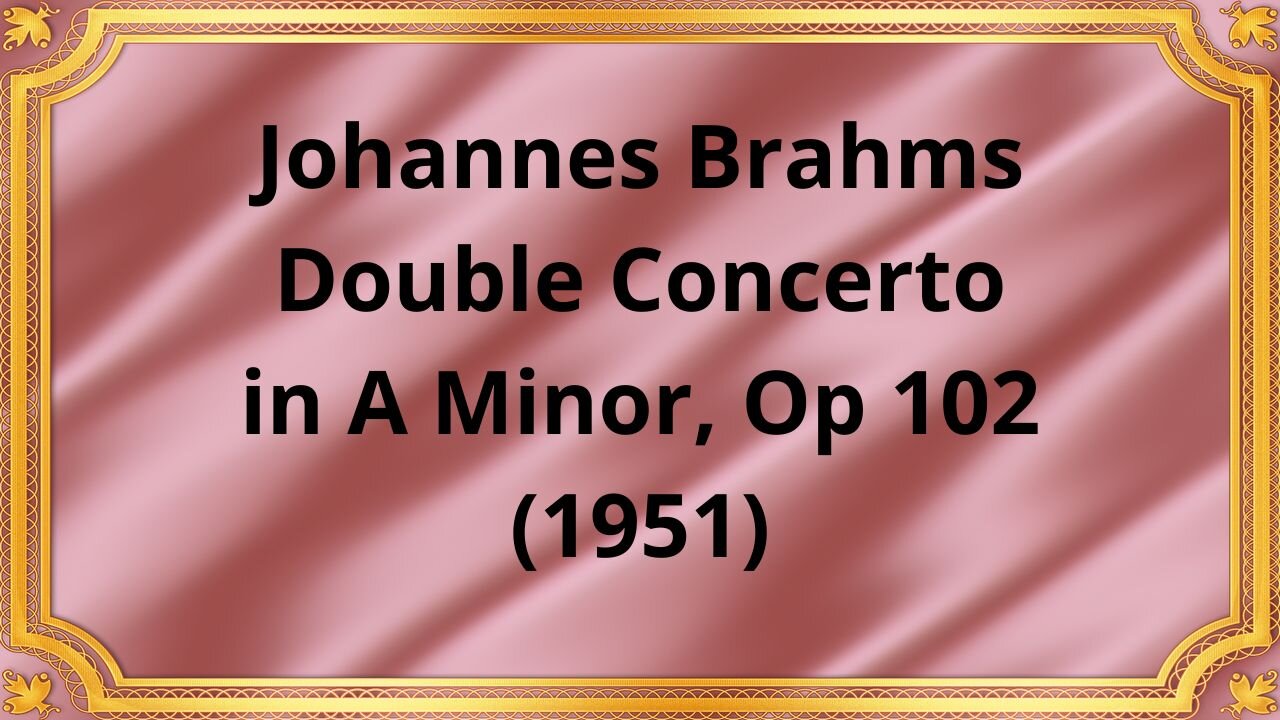Premium Only Content

Johannes Brahms Double Concerto in A Minor, Op 102 (1951)
#JohannesBrahms #DoubleConcerto #AMinor #Op102 #ClassicalMusic #MusicalComposition #BrahmsConcerto #OrchestralMusic #ViolinAndCello #RomanticEraMusic #MusicHistory #MusicAnalysis #BrahmsDoubleConcerto #ClassicalComposers #MusicTheory #Symphony #Orchestra #Concerto
Publication date 1951
Nathan Milstein Violin
Gregor Piatigorsky Cello
Fritz Reiner Conductor
The Robin Hood Dell Orchestra Of Philadelphia
Johannes Brahms, a renowned composer of the Romantic era, crafted a masterpiece with his Double Concerto in A Minor, Op. 102.
Composed in 1887, the Double Concerto marked a significant period in Brahms' career. It was a time when he sought to reconcile traditional musical forms with the innovative trends of the late Romantic era. The composition emerged as a testament to Brahms' maturity as a composer and his ability to push the boundaries of musical expression while remaining true to his classical roots.
The Double Concerto in A Minor is a concerto for violin, cello, and orchestra, comprising three movements:
1. Allegro: The opening movement introduces a sense of intensity and drama. The orchestra sets the stage with a brooding theme, followed by the soloists' entrance. The violin and cello engage in a captivating dialogue, showcasing their technical prowess and emotional depth. Brahms masterfully weaves the soloists' melodies with the rich orchestral accompaniment, creating a tapestry of contrasting moods and textures.
2. Andante: The second movement offers a respite from the intensity of the first. It unfolds as a serene and lyrical dialogue between the soloists and the orchestra, evoking a sense of introspection and profound emotion. The violin and cello trade melodic phrases, seamlessly blending their voices in a harmonious and expressive conversation.
3. Vivace non troppo: The final movement bursts forth with a lively and energetic character. It features a playful and spirited dance-like theme, showcasing the virtuosity of the soloists. Brahms skillfully combines moments of dazzling brilliance with moments of tender introspection, building towards a triumphant and exhilarating conclusion.
Brahms' Double Concerto demonstrates his mastery of harmonic progression. He artfully employs complex chord progressions and lush harmonies to create a rich and evocative musical tapestry.
The composition highlights the interplay between the solo instruments and the orchestra, with the solo violin and cello engaging in dialogues both with each other and with the accompanying ensemble. This dynamic interaction adds depth and complexity to the piece.
Brahms infuses the Double Concerto with a profound emotional depth. From moments of introspection and melancholy to passages of exuberance and joy, the piece traverses a wide range of emotions, captivating listeners with its raw and heartfelt expression.
Johannes Brahms' Double Concerto in A Minor, Op. 102 stands as a testament to the composer's artistic genius and his ability to bridge the gap between tradition and innovation. With its captivating musical structure, rich harmonies, and emotional depth, this masterpiece continues to captivate audiences and secure its place as a beloved and timeless contribution to the classical music repertoire. Its enduring legacy is a testament to Brahms' ability to create music that resonates with the human spirit across generations.
You have the opportunity to support the channel:
https://destream.net/live/RadSiarAl/donate
-
 29:54
29:54
Michael Franzese
9 hours agoCan Trump accomplish everything he promised? Piers Morgan Article Breakdown
77.6K45 -
 2:08:19
2:08:19
Tactical Advisor
13 hours agoThe Vault Room Podcast 006 | Farwell 2024 New Plans for 2025
159K11 -
 34:12
34:12
inspirePlay
1 day ago $4.66 earned🏆 The Grid Championship 2024 – Cass Meyer vs. Kelly Rudney | Epic Battle for Long Drive Glory!
65.6K8 -
 17:50
17:50
BlackDiamondGunsandGear
10 hours ago $0.24 earnedTeach Me How to Build an AR-15
41.3K4 -
 9:11
9:11
Space Ice
1 day agoFatman - Greatest Santa Claus Fighting Hitmen Movie Of Mel Gibson's Career - Best Movie Ever
103K44 -
 42:38
42:38
Brewzle
1 day agoI Spent Too Much Money Bourbon Hunting In Kentucky
68.3K12 -
 1:15:30
1:15:30
World Nomac
19 hours agoMY FIRST DAY BACK in Manila Philippines 🇵🇭
52K9 -
 13:19
13:19
Dr David Jockers
1 day ago $2.14 earned5 Dangerous Food Ingredients That Drive Inflammation
72.2K17 -
 1:05:13
1:05:13
FamilyFriendlyGaming
1 day ago $0.46 earnedCat Quest III Episode 8
126K3 -
 10:39
10:39
Cooking with Gruel
2 days agoMastering a Succulent London Broil
81.7K5